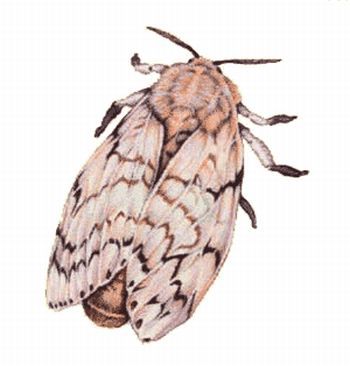
Publisher:
Bonnie King
CONTACT:
Newsroom@Salem-news.com
Advertising:
Adsales@Salem-news.com

~Truth~
~Justice~
~Peace~
TJP
Apr-02-2008 20:51

 TweetFollow @OregonNews
TweetFollow @OregonNews
Southern Oregon Site to be Treated for Gypsy Moths
Salem-News.comIntroductions of gypsy moths in Oregon can usually be traced to vehicles or outdoor household articles originating from infested areas of the northeastern U.S.
 Female gypsy moth Photo courtesy: www.agr.state.il.us |
(SALEM, Ore. ) - The state's zero tolerance policy for gypsy moths is scheduled to be on display later this month as the Oregon Department of Agriculture conducts an eradication project in Southern Oregon against the non-native plant-eating insect pest.
A 336-acre site in the Jackson County town of Shady Cove will be treated with three aerial applications of a biological insecticide that has been used routinely in other gypsy moth eradication projects in Oregon since 1984.
ODA continues its formula of early detection and rapid response after finding six gypsy moths in Shady Cove last year, and evidence of a breeding population of the invasive species.
If established, the gypsy moth could take the shade right out of Shady Cove, a community that is considered a gateway for travelers headed for Crater Lake.
"We want to protect Oregon's natural environment, and they have beautiful oak trees in the area," says ODA entomologist Barry Bai with the Insect Pest Prevention and Management Program. "With the Rogue River running through town and tourism an important part of the local economy, the residents don't want gypsy moths eating the leaves off the trees."
Loss of foliage in riparian areas can degrade fish habitat. There is also the potential economic damage caused by restrictive quarantines on commodities should gypsy moth become established.
Shady Cove is a location ODA has been watching for some time. Two gypsy moths were detected in the area in both 2005 and 2006. But it wasn't until last year that officials had enough evidence to propose an eradication project.
"After finding six gypsy moths in a single trap in the area last summer, we began interviewing residents," says Bai. "One person told us they had traveled with their trailer back to Pennsylvania to visit relatives in June. When they were back there, they saw gypsy moth caterpillars crawling all over the place. As a result of their information, we found gypsy moth pupal cases and even a live egg mass on site in Shady Cove."
Introductions of gypsy moths in Oregon can usually be traced to vehicles or outdoor household articles originating from infested areas of the northeastern U.S. When people move to or visit Oregon from these infested areas, the gypsy moth or its eggs hitches a ride. Many out-of-state tourists will travel through Shady Cove on their way to or from Crater Lake National Park, and recreational vehicles often stop in town for awhile, which may explain the previous gypsy moth detections in 2005 and 2006.
ODA is planning three aerial applications in late April and early-to-mid May of the biological insecticide Bacillus thuringiensis var. kurstaki (Btk), which has an excellent safety record while being effective in ridding the moth. Early morning applications by helicopter are scheduled to take place roughly 10 to 14 days apart, depending on weather conditions. The product this year also carries organic certification and can be safely used in areas where organic gardens may be planted. ODA has been working with city officials in Shady Cove and Jackson County health officials to clearly communicate the eradication plan. A public information meeting held in February provided residents of the area a chance to ask questions and get answers.
"We are all on the same page right now," says Bai, who will be on site for the three applications.
This year's gypsy moth effort is a step down from 2007's activity. ODA conducted two separate eradication efforts last year– one in Bend, the other in St. Helens– following the detection of 66 gypsy moths statewide in 2006. Once the spraying was completed last spring, a high density of traps were placed in both Bend and St. Helens. The good news is that no gypsy moths were trapped in either location last summer and there has been no need to repeat the spraying this year. Another year of zero catches at both locations will go a long way in proving that the 2007 gypsy moth eradication projects were successful.
The 2008 eradication project will overlap another important component of ODA's gypsy moth program– the detection phase. Next month, the first of thousands of traps will be placed throughout the state to monitor any emerging gypsy moth problems. These tent-like traps contain a female pheromone that attracts any male gypsy moths in the area. They will be checked during the season and eventually removed after the summer months.
There are five other sites in Oregon where gypsy moth detections were made last year but no eradication efforts are planned this spring. They include Eugene, Clatskanie in Columbia County, Sunriver in Deschutes County, Wasco in Sherman County, and Murphy in Josephine County. All sites where gypsy moths were detected last year will receive extra attention this spring as a higher density of traps are placed in those areas.
While many states back east have succumbed to the devastating pest, Oregon still has a chance to keep gypsy moth from becoming a permanent resident.
"We've been very successful in holding the line on gypsy moths," says Bai. "Infested states back east have to live with gypsy moth and suppress gypsy moth populations on a yearly basis. States at the front edge of the insect's distribution want to slow the spread. For western states like Oregon and Washington, gypsy moth has not been established. We have had a strong trapping program combined with a rapid response to eradicate gypsy moth populations when they are first detected."
In the mid-1980s, more than 225,000 acres were sprayed in Lane County alone after some 19,000 gypsy moths were trapped. Certainly, treating 336 acres after catching six moths is much less expensive for the state and far less intrusive to the residents of Shady Cove. ODA officials hope by catching the gypsy moth early and treating the area quickly, Oregonians won't have to learn to coexist with the insect.
"We are hopeful that the project in Shady Cove this spring will be just a one-year treatment," says Bai.
Articles for April 1, 2008 | Articles for April 2, 2008 | Articles for April 3, 2008
Quick Links
DINING
Willamette UniversityGoudy Commons Cafe
Dine on the Queen
Willamette Queen Sternwheeler
MUST SEE SALEM
Oregon Capitol ToursCapitol History Gateway
Willamette River Ride
Willamette Queen Sternwheeler
Historic Home Tours:
Deepwood Museum
The Bush House
Gaiety Hollow Garden
AUCTIONS - APPRAISALS
Auction Masters & AppraisalsCONSTRUCTION SERVICES
Roofing and ContractingSheridan, Ore.
ONLINE SHOPPING
Special Occasion DressesAdvertise with Salem-News
Contact:AdSales@Salem-News.com


googlec507860f6901db00.html


Terms of Service | Privacy Policy
All comments and messages are approved by people and self promotional links or unacceptable comments are denied.
[Return to Top]
©2025 Salem-News.com. All opinions expressed in this article are those of the author and do not necessarily reflect those of Salem-News.com.